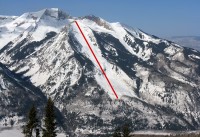
Cleaver avalanche path, Colorado, extent of 2005 ‘full path’ slide is marked as one would shoot alpha angle if they were standing at the bottom next to the trees that were still standing. This is a quiz hint.
If you try the quiz, please fill out all answers thoughtfully as we do have an anonymous database of the answers and would like to keep it real. If you don’t know an answer, do your best guess. Do not leave answers blank.
As for your score, bear in mind that lower numbers are better.
Basically, the numerical scoring works like this, though it could be changed:
– 0 – 1000 “Very little risk of dying in an avalanche.” Somewhat difficult to achieve this score if you’re honest about your answers. About 3,000 quiz results in this range. Due to flaw in quiz software I might have included some incomplete quizzes in these results.
– 1001-2700 “Moderate risk level, keep working on safety.” About 6,000 results in this range, we feel most backcountry skiers are in this category.
– 2701-4399 “Red zone, take note and modify agenda.” About 300 results in this range (3%).
– 4400-5000 “Extreme risk level, complete stop of backcountry skiing recommended until changes are made.” We only have about 20 results in this range, some could have been software tests.
To keep the library of associated blog comments intact, I re-dated this blog entry as today (original publication of quiz and this post was September 20, 2006).
Without more blabber from me, check it out and let us know what you think — and if you’re safe enough to ski with (grin). (Please complete all questions.)
Please leave feedback here and we’ll continue to change and improve the quiz.
If you link to the backcountry skiing avalanche risk quiz directly, please use the following URL:
https://wildsnow.com/avalanche-safety-information/avalanche-safety-quiz/
Original 2006 blog post below
***************************************
We’ve been wanting to create an avalanche risk self evaluation quiz for quite a while, more as a learning tool than anything else, but also for fun. The idea is to stimulate thought and improvements in how we go about staying alive in avalanche country. We decided to go public but it’s still a work in progress, so your comments are highly appreciated. The thrust of the project is to get away from gear issues as a measurement of personal safety. Ditto for book learning. Instead, the quiz weighs your answers in a variety of ways and tries to come up with an evaluation of your personal safety style. We use gear and knowledge questions, but mix those up with “human factor” questions and some goofy stuff just for fun.
WildSnow.com publisher emeritus and founder Lou (Louis Dawson) has a 50+ years career in climbing, backcountry skiing and ski mountaineering. He was the first person in history to ski down all 54 Colorado 14,000-foot peaks, has authored numerous books about about backcountry skiing, and has skied from the summit of Denali in Alaska, North America’s highest mountain.
